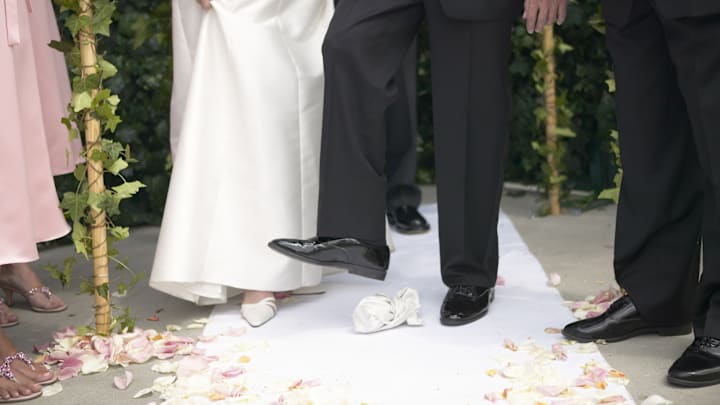As the end of a traditional Jewish wedding draws near, the bride and groom gather under a fabric canopy supported by four poles. This canopy, known as a chuppah, symbolizes the couple’s joining under one roof; the open sides reflect their promise to maintain a home that always welcomes others, just like the ancient tent of Abraham and Sarah. It’s believed that the Shechinah (or Shekhinah), the presence of God, visits a couple under the chuppah, alongside the spirits of deceased family members, who descend to join the wedding festivities.
This sacred setting is where the iconic glass-breaking ritual occurs. Thoroughly wrapped up in cloth to prevent injury, a glass—any kind will do, as long as it’s likely to shatter—is placed on the floor and smashed underfoot. As the chuppah was historically the “groom’s realm,” it used to be that only the groom took part in it. However, the bride is likely to join in on the fun nowadays, potentially even smashing her own glass at the same time.
But where did this famous tradition come from, and what does it mean? The practice is so old that it’s hard to say exactly when and how it originated, but the most common interpretation comes from the writings of the Jewish text, the Talmud, dating back to the 4th century CE. In Berakhot 5:2, the following verse appears:
“Mar, the son of Rabina, made a marriage banquet for his son; when he observed that the Rabbis were at the height of their merriment, he brought in a very costly cup worth four hundred zouzim and broke it before them; and they grew sad.”
In other words, the Talmud says that temperance is necessary, even in times of celebration. By the Middle Ages, that idea had come to explicitly mean remembering the destruction of Jewish temples in Jerusalem during wedding celebrations, one of the happiest times in a person’s life. For that reason, a Rabbi or cantor (chazan) will often sing “Im Eshkakech Yerushalayim” (translated as “If I Forget You, Jerusalem”) before the glass-breaking as an opportunity for somber reflection.
But as with any long-standing tradition, many interpretations of its meaning have cropped up over the years—and not all of them are so solemn. In the olden days, it was extra important that the groom break the glass, as it was considered symbolic of breaking the hymen during intercourse. Some view the glass smashing as reflective of the couple’s happy days ahead, affirming that the marriage is not about material goods. One tongue-in-cheek explanation jokes that this moment will be the last time the groom can put his foot down.
In any case, the breaking of the glass tends to be one of the most anticipated and emotional events of the wedding, leading many couples to have the shattered glass made into various keepsakes. Despite the practice’s many meanings, one thing is for sure: when you hear the glass shatter, don’t forget to congratulate the happy couple with a jubilant shout of “Mazel tov!”
Have you got a Big Question you'd like us to answer? If so, let us know by emailing us at bigquestions@mentalfloss.com.
